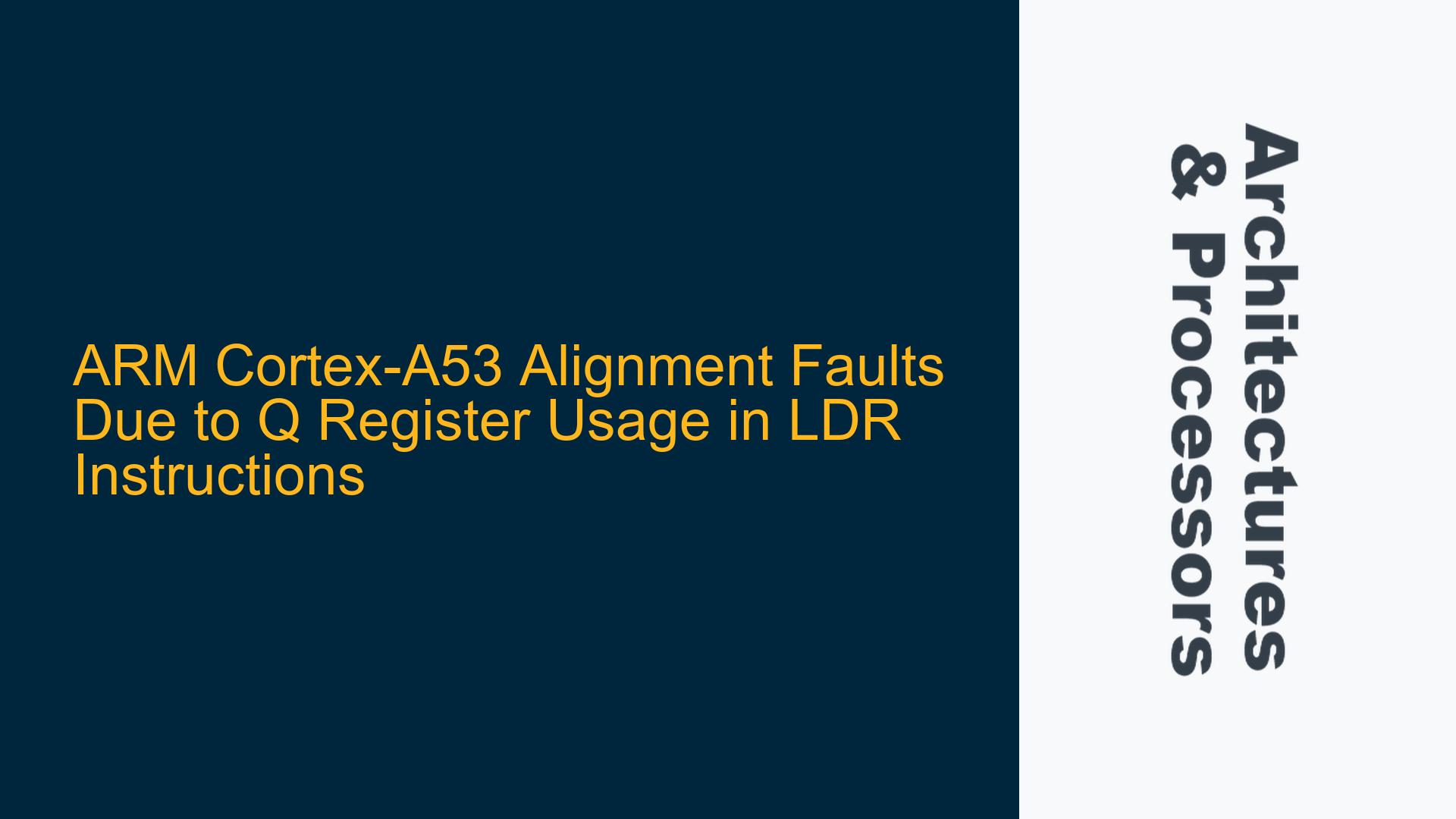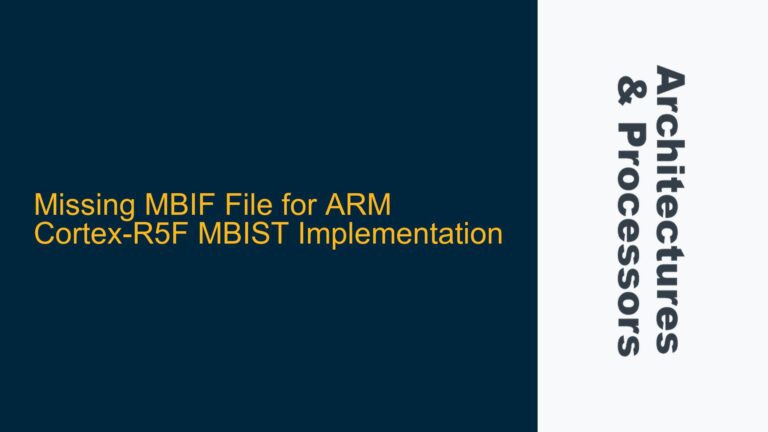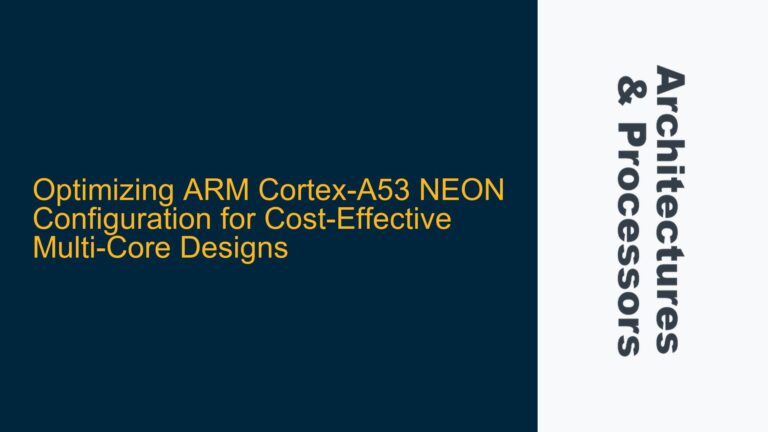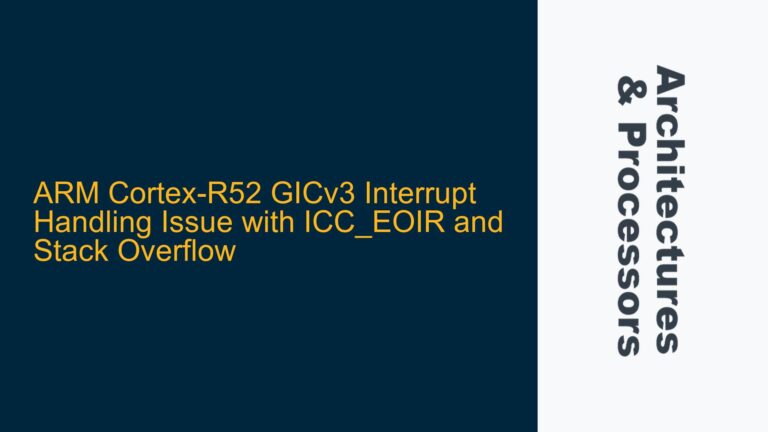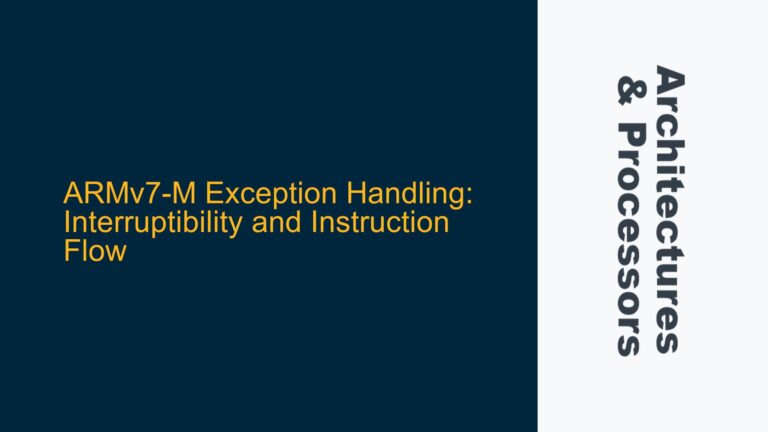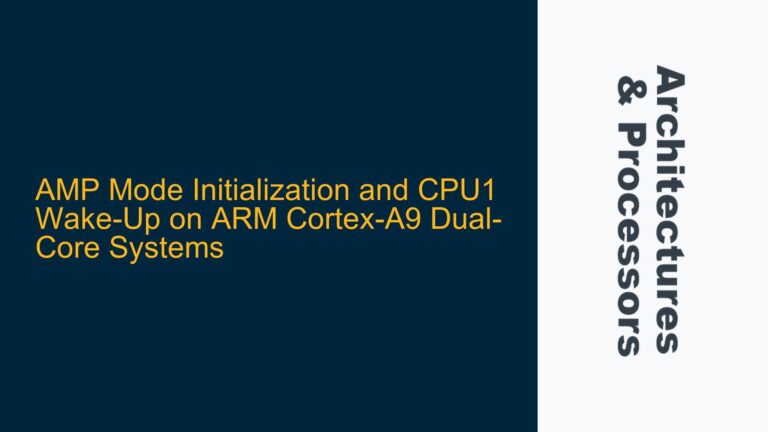ARM Cortex-A53 Alignment Faults During Single Float Load Operations
When working with the ARM Cortex-A53 processor, a common issue arises when the compiler generates ldr q0, [x1, #0] instructions for single float load operations, such as scratch_in[0] = Fin_r[0 * in_step];. This instruction attempts to load a 128-bit value into the Q register (Q0) from a memory address that is not 128-bit aligned. In this case, the address 0x1000000c is only 32-bit aligned, leading to an alignment fault. The fault is indicated by the exception syndrome register ESR_EL3 with the value 0x96000021, which corresponds to an alignment fault.
The root of the problem lies in the compiler’s decision to use a Q register for a single float load operation. Q registers are part of the ARM Advanced SIMD (Neon) architecture and are designed for 128-bit wide data operations. When the compiler generates a ldr q0, [x1, #0] instruction, it assumes that the memory address is 128-bit aligned. If the address is not aligned, the processor raises an alignment fault, as the Cortex-A53 does not support unaligned accesses for Q registers.
This issue is particularly problematic in embedded systems where memory alignment is often not guaranteed, especially when dealing with dynamically allocated memory or data structures that are not explicitly aligned. The alignment fault can cause the program to crash or behave unpredictably, making it critical to address this issue during the development phase.
Compiler Optimization and Neon Intrinsics Leading to Q Register Usage
The primary cause of this issue is the compiler’s optimization strategy and its use of Neon intrinsics. When compiling code with the -mfpu=neon flag, the ARM compiler (armclang) is instructed to utilize the Neon SIMD unit for floating-point operations. The compiler may decide to use Q registers for load operations, even when loading a single float value, as part of its optimization strategy to minimize the number of instructions or to prepare for potential SIMD operations later in the code.
In the given example, the compiler generates a ldr q0, [x1, #0] instruction for the operation scratch_in[0] = Fin_r[0 * in_step];. This decision is influenced by the following factors:
-
Neon Optimization: The compiler attempts to optimize the code by using Neon instructions, which are designed for parallel processing of multiple data elements. Even though only a single float is being loaded, the compiler may use a Q register to align with potential future SIMD operations.
-
Alignment Assumptions: The compiler assumes that the memory address is 128-bit aligned when using Q registers. This assumption is based on the alignment requirements of the Neon architecture, which mandates 128-bit alignment for Q register operations.
-
Compiler Flags: The use of the
-mfpu=neonflag enables Neon instructions, and the-mcpu=cortex-a53flag specifies the target processor. These flags influence the compiler’s decision to use Q registers for load operations. -
Data Type and Pointer Arithmetic: The data types involved (
float*) and the pointer arithmetic (0 * in_step) may also influence the compiler’s decision. The compiler may interpret the operation as part of a larger SIMD pattern, leading to the use of Q registers.
Preventing Q Register Usage and Ensuring Proper Memory Alignment
To resolve the alignment fault issue and prevent the compiler from using Q registers for single float load operations, several approaches can be taken. These approaches involve modifying the code, adjusting compiler flags, and ensuring proper memory alignment.
1. Use Scalar Load Instructions Instead of Neon Instructions
One of the most straightforward solutions is to force the compiler to use scalar load instructions instead of Neon instructions. This can be achieved by modifying the code to explicitly use scalar operations or by adjusting the compiler flags to disable Neon optimizations for specific sections of the code.
For example, the code can be modified as follows:
float temp = Fin_r[0 * in_step];
scratch_in[0] = temp;
This modification ensures that the compiler generates a scalar load instruction (ldr s0, [x1, #0]) instead of a Neon load instruction (ldr q0, [x1, #0]). The scalar load instruction does not require 128-bit alignment and will not cause an alignment fault.
2. Disable Neon Optimizations for Specific Code Sections
If modifying the code is not feasible, Neon optimizations can be disabled for specific code sections using compiler pragmas. This approach allows the rest of the code to benefit from Neon optimizations while preventing alignment faults in critical sections.
For example, the following pragma can be used to disable Neon optimizations for a specific function:
#pragma clang optimize off
void critical_function(float* scratch_in, float* Fin_r, int in_step) {
scratch_in[0] = Fin_r[0 * in_step];
}
#pragma clang optimize on
This pragma instructs the compiler to disable optimizations for the critical_function, ensuring that scalar load instructions are used instead of Neon instructions.
3. Ensure Proper Memory Alignment
Another approach is to ensure that the memory addresses used in the code are properly aligned. This can be achieved by aligning the data structures or dynamically allocated memory to 128-bit boundaries. The ARM Cortex-A53 processor supports aligned memory accesses for Q registers, and ensuring proper alignment will prevent alignment faults.
For example, the following code ensures that the Fin_r array is 128-bit aligned:
float* Fin_r __attribute__((aligned(16))) = (float*)malloc(sizeof(float) * N);
This code uses the aligned attribute to ensure that the Fin_r array is aligned to a 16-byte (128-bit) boundary. This alignment ensures that the ldr q0, [x1, #0] instruction will not cause an alignment fault.
4. Use Compiler Flags to Control Neon Usage
Compiler flags can be adjusted to control the use of Neon instructions. For example, the -fno-vectorize flag can be used to disable vectorization, which may prevent the compiler from using Q registers for single float load operations.
The following command disables vectorization:
armclang.exe --target=aarch64-arm-none-eabi -mcpu=cortex-a53 -mfpu=neon -mfloat-abi=hard -marm -mcmse -fno-vectorize filename.c
This flag instructs the compiler to avoid vectorizing the code, which may reduce the likelihood of using Q registers for single float load operations.
5. Use Inline Assembly for Critical Load Operations
In some cases, it may be necessary to use inline assembly to ensure that scalar load instructions are used for critical load operations. This approach provides precise control over the generated instructions and ensures that alignment faults are avoided.
For example, the following inline assembly code ensures that a scalar load instruction is used:
float temp;
__asm__ volatile (
"ldr %s0, [%1, #0]"
: "=w"(temp)
: "r"(Fin_r)
);
scratch_in[0] = temp;
This inline assembly code uses the ldr instruction with the %s0 format specifier to load a single float value into a scalar register. This approach ensures that the compiler does not generate a Neon load instruction.
6. Analyze and Modify Compiler Optimization Levels
The compiler’s optimization level can also influence the decision to use Q registers for single float load operations. Higher optimization levels may increase the likelihood of the compiler using Neon instructions, while lower optimization levels may favor scalar instructions.
For example, the following command reduces the optimization level:
armclang.exe --target=aarch64-arm-none-eabi -mcpu=cortex-a53 -mfpu=neon -mfloat-abi=hard -marm -mcmse -O1 filename.c
This command sets the optimization level to -O1, which may reduce the likelihood of the compiler using Q registers for single float load operations.
7. Use Compiler-Specific Attributes to Control Instruction Selection
Some compilers provide attributes that can be used to control instruction selection. For example, the ARM compiler provides the __attribute__((noinline)) attribute, which can be used to prevent the compiler from inlining a function and potentially using Neon instructions.
For example, the following code uses the noinline attribute to prevent inlining:
__attribute__((noinline)) void load_float(float* scratch_in, float* Fin_r, int in_step) {
scratch_in[0] = Fin_r[0 * in_step];
}
This attribute ensures that the function is not inlined, which may prevent the compiler from using Q registers for single float load operations.
8. Review and Modify Data Structures
Finally, it may be necessary to review and modify the data structures used in the code to ensure that they are compatible with the alignment requirements of the Neon architecture. This may involve reorganizing data structures, adding padding, or using aligned memory allocators.
For example, the following code adds padding to ensure that the Fin_r array is 128-bit aligned:
struct aligned_float {
float value;
char padding[12]; // Ensure 16-byte alignment
};
struct aligned_float Fin_r[N];
This code ensures that each element of the Fin_r array is 16-byte aligned, which prevents alignment faults when using Q registers.
Conclusion
The issue of alignment faults due to Q register usage in ldr instructions on the ARM Cortex-A53 processor can be addressed through a combination of code modifications, compiler flag adjustments, and memory alignment strategies. By understanding the underlying causes of the issue and applying the appropriate solutions, developers can ensure that their code runs reliably on the Cortex-A53 processor without encountering alignment faults.
